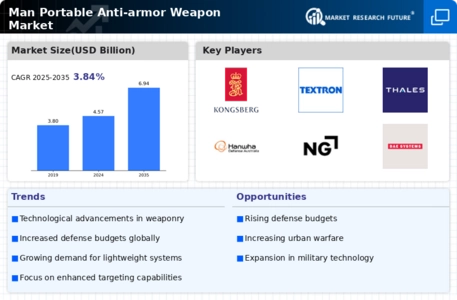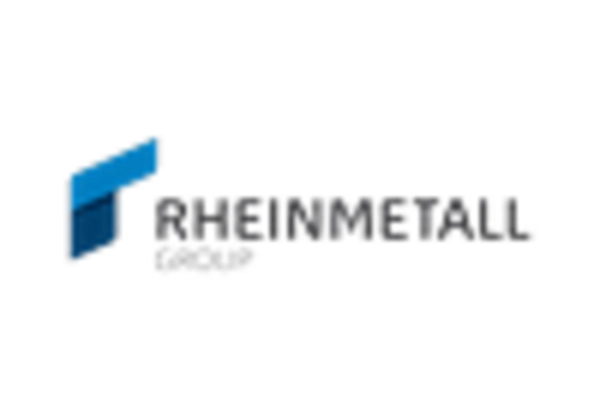Emerging Markets
The Man Portable Anti-armor Weapon Market is witnessing growth in emerging markets, where defense capabilities are being rapidly developed. Countries in regions such as Asia and the Middle East are investing in modernizing their armed forces, which includes the acquisition of man-portable anti-armor systems. The increasing awareness of the need for effective defense mechanisms against armored threats is driving this trend. Reports suggest that the market in these regions could grow at a compound annual growth rate of over 7% in the coming years. As these nations seek to enhance their military readiness, the demand for advanced anti-armor solutions is expected to rise, presenting opportunities for manufacturers to expand their reach.
Geopolitical Tensions
The Man Portable Anti-armor Weapon Market is significantly influenced by rising geopolitical tensions around the world. As conflicts and territorial disputes escalate, nations are compelled to bolster their military capabilities, particularly in anti-armor warfare. The ongoing conflicts in various regions have underscored the necessity for effective portable anti-armor solutions. This has led to an increased focus on developing and procuring advanced systems that can be deployed rapidly in combat situations. The heightened sense of insecurity among nations is likely to sustain the demand for man-portable anti-armor weapons, as military strategists recognize the importance of maintaining a tactical edge in potential confrontations.
Increased Defense Budgets
The Man Portable Anti-armor Weapon Market is benefiting from increased defense budgets across various nations. Governments are allocating more resources to enhance their military capabilities, particularly in response to evolving threats. For example, recent reports indicate that defense spending in several countries has risen by an average of 5% annually over the past few years. This trend is likely to continue as nations prioritize the acquisition of advanced weaponry, including man-portable anti-armor systems. The emphasis on modernization and readiness is driving procurement strategies, leading to a robust market for these weapons. As defense budgets expand, manufacturers are positioned to capitalize on the growing demand for innovative solutions that can effectively counter armored threats.
Technological Advancements
The Man Portable Anti-armor Weapon Market is experiencing a surge in technological advancements, which significantly enhances the effectiveness and efficiency of these weapons. Innovations such as improved guidance systems, lightweight materials, and advanced warhead designs are being integrated into new models. For instance, the development of smart munitions that can adjust their trajectory mid-flight is becoming more prevalent. This not only increases the hit probability but also expands the operational range of these weapons. As militaries seek to modernize their arsenals, the demand for cutting-edge anti-armor solutions is likely to rise. Furthermore, the integration of digital technologies, such as artificial intelligence, into targeting systems is expected to revolutionize the way these weapons are deployed in combat scenarios.
Focus on Asymmetric Warfare
The Man Portable Anti-armor Weapon Market is increasingly shaped by the focus on asymmetric warfare strategies. As military engagements evolve, there is a growing recognition of the need for portable and versatile anti-armor solutions that can be deployed by smaller, agile units. This shift is particularly relevant in counterinsurgency operations, where traditional armored units may face unconventional threats. The demand for lightweight, easily transportable anti-armor weapons is likely to increase as armed forces adapt to these new operational paradigms. Furthermore, the emphasis on enhancing the capabilities of infantry units to engage armored threats effectively is expected to drive innovation and procurement in the man-portable anti-armor segment.


















Leave a Comment